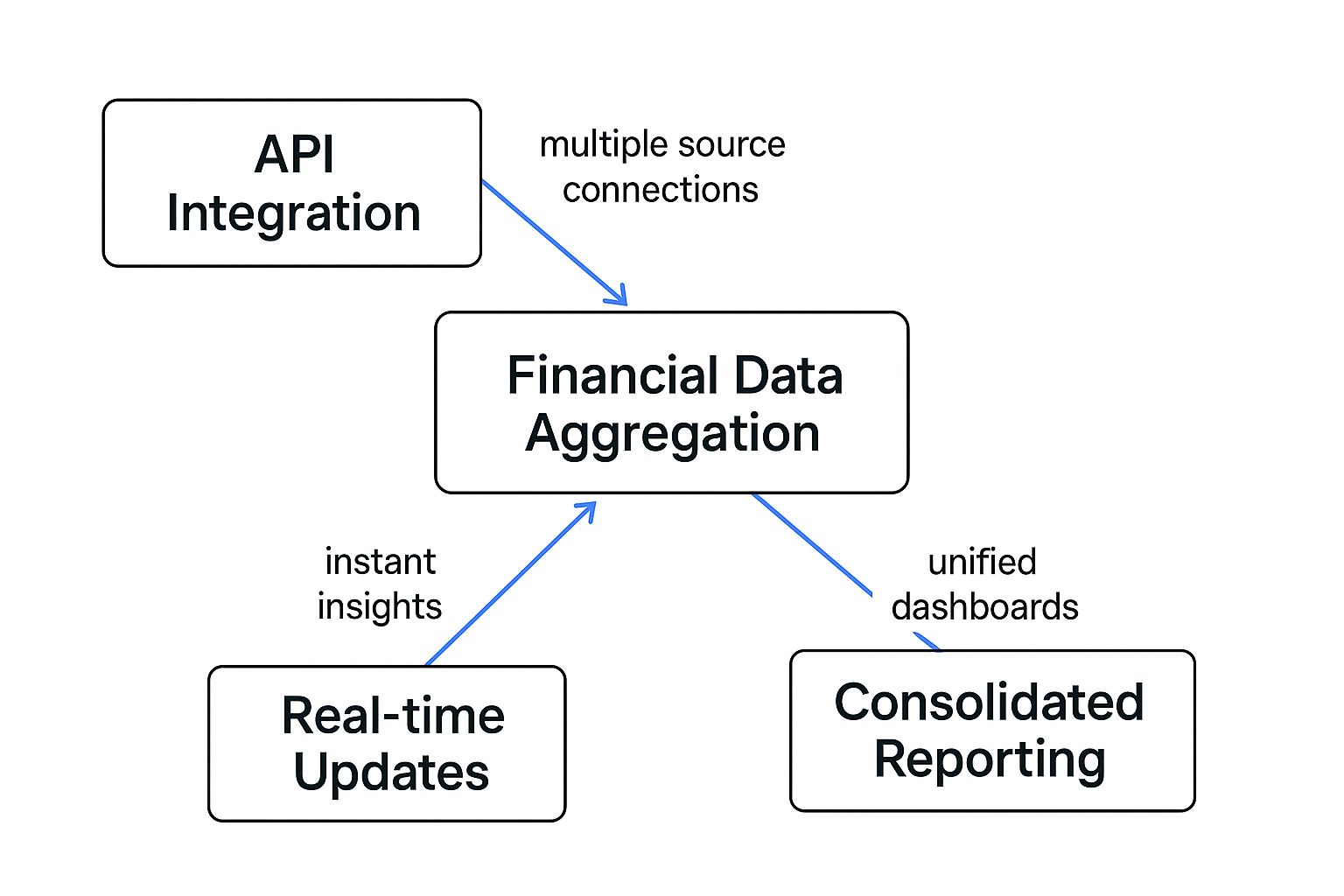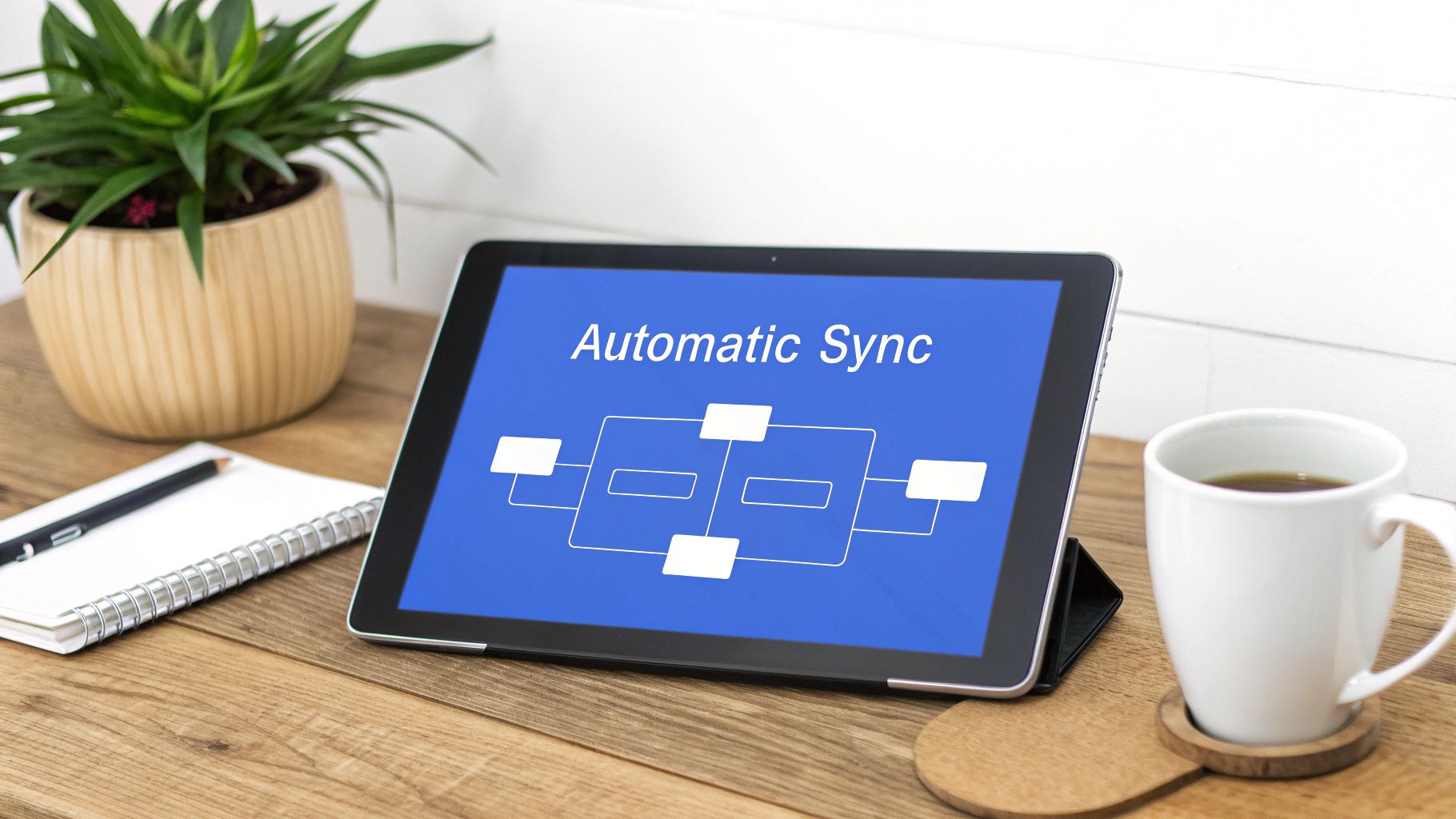Our Marketing Team at PopaDex
Financial Data Aggregation: Simplify Your Money Management

Making Sense Of Financial Data Aggregation (Without The Jargon)

Imagine a personal financial assistant that gathers all your financial information – from checking accounts and credit cards to investments and loans – and presents it in a clear, concise summary. That’s financial data aggregation in a nutshell. It’s the technology powering many apps and services you probably use every day, like budgeting apps and personal finance platforms such as PopaDex.
How Does Financial Data Aggregation Work?
Financial data aggregation connects to your various financial institutions and retrieves your account information. Think of it as a central hub for all your financial data.
Instead of logging into multiple accounts separately, you can see your complete financial picture in one place. Imagine viewing your checking account balance, credit card debt, and investment performance all on a single dashboard.
This consolidated view simplifies money management and makes it easier to spot trends and areas for potential improvement.
The Rise of Open Banking and APIs
This practice has become especially important with the rise of open banking. Open banking securely allows third-party providers access to your financial data, with your explicit permission, through Application Programming Interfaces (APIs).
APIs are like messengers, allowing different systems to communicate and exchange information seamlessly. This is a significant improvement over older methods like screen scraping, which extracted data from website screens – a process that was less secure and more prone to errors.
Financial data aggregation has become crucial to modern finance, especially with the rise of open banking. This trend gained momentum around 2016 when the European Union’s Second Payment Services Directive (PSD2) laid the groundwork for open banking. PSD2 requires banks to share customer data with authorized third parties via APIs. By 2020, open banking had become a major force in financial technology innovation, leading to the creation of many companies offering financial data aggregation services. Dive deeper into the world of financial data aggregation.
Benefits of Financial Data Aggregation
The benefits of financial data aggregation go beyond simple convenience. It’s a powerful way to take control of your finances.
-
Comprehensive Overview: See all your accounts in one place for a holistic view of your financial health.
-
Simplified Tracking: Easily monitor spending, income, and investments, simplifying budgeting and financial planning.
-
Improved Decision-Making: Make informed choices based on accurate, up-to-date financial data.
-
Time Savings: Eliminate logging into multiple accounts individually, saving you valuable time and effort.
These benefits are changing how individuals and businesses manage their money. With the right tools and understanding, you can unlock the full potential of your financial data and reach your financial goals.
The Secret Technology That Makes Your Money Apps Work

The infographic above illustrates the key advantages of financial data aggregation. Notice how it uses API integration to connect to multiple sources, delivers real-time updates for quick insights, and presents everything in a unified dashboard. These combined features offer a powerful and efficient approach to managing your personal finances.
From Screen Scraping to APIs: The Evolution of Data Connections
Ever wonder how these apps get access to your financial data? Early on, many used a method called screen scraping. Imagine a little robot logging into your bank account just like you, then copying and pasting the information it sees on the screen. This method, while functional, was slow, often inaccurate, and presented security risks.
Now, most financial data aggregation relies on Application Programming Interfaces (APIs). Think of an API as a secure courier delivering data between your bank and the app you’re using. This exchange allows for quicker, more dependable, and safer data transfer. For example, when you buy your morning coffee, the transaction details are zipped over to your budgeting app almost instantaneously via API.
The Infrastructure Behind the Scenes
APIs are just one part of a bigger picture. These aggregators connect to thousands of different financial institutions, standardize the data they receive, and essentially act as a bridge between banks and financial apps. They pull together information from bank accounts, credit cards, investments, loans, and other financial products to create a complete overview of your financial situation. Find more information about financial data aggregation here. All of this requires a powerful infrastructure to manage the huge amount of data moving between these systems.
To help clarify the differences between manual and automated data aggregation (through APIs), let’s look at a comparison table:
Data Aggregation Methods Comparison
| Method | Speed | Accuracy | Security | Best For |
|---|---|---|---|---|
| Manual | Slow | Prone to human error | Depends on individual practices | Tracking a few accounts infrequently, maximum control over data |
| Automated (APIs) | Fast, often real-time | High, automated checks reduce errors | Generally secure, depends on API implementation | Tracking numerous accounts, frequent updates, efficient management |
As you can see, automated aggregation via APIs offers significant advantages in speed and accuracy. While manual methods give you ultimate control, they are time-consuming and more susceptible to errors.
The Role of Open Banking
The rise of open banking has greatly accelerated the development of financial data aggregation. Open banking, often driven by government regulation, requires banks to share customer data with authorized third parties through secure APIs. This creates a more standardized and secure environment for sharing data, leading to greater innovation in financial technology. This also results in a greater variety of financial management tools, such as those discussed in Assessing Your Wealth: A Comparative Study of Mint, Excel, and Premier Net Worth Applications. This means you have more choices and more control over your financial data. By understanding how things work behind the scenes, you can choose the financial tools that best fit your needs and security preferences. Keep in mind that some apps offer real-time updates, while others can take days; it all depends on how they access and process data.
The Truth About Security (And What Really Keeps Your Data Safe)

This screenshot from Wikipedia’s Open Banking page shows how our financial data is connected these days. See how you, the consumer, are at the center? You’re giving permission for outside services to access your data through secure channels (APIs), creating a more connected financial experience.
Sharing your financial details online might feel a bit like opening your home to strangers. But understanding the security measures around financial data aggregation can put your mind at ease. Let’s explore the technical and regulatory safeguards protecting your information.
Bank-Level Encryption and Secure APIs
Most trustworthy financial data aggregators use bank-level encryption. This is the same technology banks use to protect your online transactions. APIs, or Application Programming Interfaces, act like carefully guarded doors. They only share specific data with authorized apps, never your login details. Think of it like sending a messenger with a specific request, instead of giving them your house keys.
Imagine you want your friend to pick up your dry cleaning. You give them a note with the order number, not the keys to your house and car. APIs work in a similar way, only releasing specific data, not your full account access.
Read-Only Access vs. Credential Storage
How apps access your information matters. Some services need your banking login details, while others use read-only access. Read-only means they can see your data, but not make changes. This read-only access adds a big layer of security. If a read-only app were hacked, the bad guys couldn’t move your money.
Regulatory Frameworks: PCI DSS and GDPR
Financial data aggregation isn’t the Wild West. Regulations like the PCI DSS (Payment Card Industry Data Security Standard) and GDPR (General Data Protection Regulation) are in place to protect you. These rules dictate how companies handle your data, mandating strict security measures. This oversight is there to keep your data safe and sound.
Data Ownership and Company Acquisitions
What happens to your data if a company is bought or closes its doors? You might be surprised to learn that you still own your data. Reputable services are just looking after it. They’re required to protect it and often delete it if you ask or when the service ends. Still, it’s good to be aware of wider industry issues. For example, check out this article on insurance industry problems to see some of the challenges facing the financial sector. Keeping up with these trends helps you make informed decisions.
Red Flags and Practical Questions
While security is a priority for most services, look out for red flags. Be cautious of apps wanting too much access, having unclear privacy policies, or a website that looks unprofessional. Before linking your accounts, ask some important questions: How is my data protected? What happens to my data if the company goes out of business? Do they store my login information? Asking these questions gives you the power to choose wisely.
By understanding how financial data aggregation works and the measures in place to protect your information, you can confidently use these tools to get a better grip on your finances. This informed approach lets you enjoy the benefits of these services, like the insights offered by PopaDex, with greater peace of mind.
Real Stories: How Financial Data Aggregation Changes Lives
Meet Sarah, a freelance designer. Juggling projects and income across five different platforms, keeping track of her earnings used to feel like a constant game of catch-up with spreadsheets and manual calculations. Then there’s David, a small business owner. He was shocked to discover, thanks to financial data aggregation, that he was paying for three unused subscriptions, a hidden cost draining hundreds of dollars each month.
These aren’t just made-up scenarios. They highlight how financial data aggregation is changing how we manage our money. From freelancers like Sarah to business owners like David, this technology offers practical solutions for everyday money matters.
From Spreadsheets to Streamlined Finances: Personal Case Studies
For Sarah, connecting her payment platforms to a financial data aggregation app was a game-changer. Suddenly, she had a clear, consolidated view of her income. Tax season transformed from a dreaded ordeal into a manageable task. No more scrambling for invoices or tedious reconciliation – the app handled it all. This newfound clarity also gave her the insights to make smarter business decisions, like identifying her most profitable clients and adjusting her pricing accordingly.
David’s experience underscores the importance of having a complete financial overview. Aggregating his business expenses revealed hidden costs that were quietly impacting his bottom line. Canceling those redundant subscriptions freed up valuable capital he could reinvest in growing his business. For David, financial data aggregation wasn’t just about saving money; it was about gaining control and ensuring the long-term health of his business. Protecting financial data is paramount, and exploring options like asset protection insurance can provide an additional layer of security.
Popular Applications: Mint, YNAB, and Tiller
The practical benefits of financial data aggregation are fueling the rise of apps like Mint, YNAB (You Need a Budget), and Tiller. Each platform uses this technology in unique ways to cater to different needs.
-
Mint provides a big-picture view of your financial health, offering snapshots of your spending habits, net worth, and credit score.
-
YNAB puts budgeting front and center, helping you allocate every dollar and take control of your spending.
-
Tiller integrates with Google Sheets, giving you the flexibility to customize your financial tracking and analysis.
Whether you’re a visual learner who appreciates Mint’s charts and graphs, or a spreadsheet enthusiast who prefers Tiller’s customization, there’s likely a financial data aggregation tool that fits your style.
Business Applications: Reshaping Financial Management
Beyond personal finance, financial data aggregation is reshaping how businesses handle their finances. From simplifying expense reports to providing real-time cash flow insights, these tools offer new levels of visibility and control.
Imagine a company that can automatically categorize and track expenses across all departments. This eliminates manual data entry and reduces the risk of errors. Or think of a business owner who can instantly see their cash flow projections, empowering them to make data-driven decisions about investments and expansion.
Choosing the Right Tool: Finding Your Best Fit
The true power of financial data aggregation lies in choosing the right tool for your specific needs. Are you a young professional managing student loans and building a savings plan? Are you a family saving for a down payment on a house? Or are you a retiree focused on optimizing your investment portfolio?
Understanding how each platform leverages financial data aggregation helps you select the best tool for your goals, allowing you to take control of your financial future. This informed approach can change your relationship with money, making it easier to manage, track, and grow your wealth.
The Explosive Growth Reshaping Financial Services

The image above illustrates the impressive growth of the financial data aggregation market. This isn’t just about bigger numbers; it’s a real shift in how we manage our money. Several factors are fueling this growth, including new regulations, technological advances, and changing consumer needs.
Open Banking: The Catalyst for Change
One of the biggest game-changers is open banking. This system requires banks to share customer data with approved third-party providers through secure APIs. Imagine giving a trusted friend access to certain files on your computer – they can see and use the data, but not alter or delete it. Open banking works similarly.
This access empowers consumers with a more complete picture of their finances, leading to better decisions. It also boosts competition and innovation across financial services.
Consumer Demand for Transparency and Control
People increasingly want more transparency and control over their financial data. They want a single view of all their accounts, the ability to track spending, and the power to make informed choices about their money.
This demand has created a perfect environment for fintech companies to develop helpful tools and services. Think budgeting apps and sophisticated wealth management platforms – all made possible by financial data aggregation.
The Role of AI and Machine Learning
Artificial intelligence (AI) and machine learning are also reshaping financial data aggregation. These technologies analyze massive amounts of data to spot trends, predict future outcomes, and offer personalized financial advice.
AI-powered tools can help you identify savings opportunities, optimize your investments, and even detect fraud. This level of insight used to be exclusive to wealthy individuals with personal financial advisors. Now, it’s becoming accessible to everyone thanks to financial data aggregation and AI.
Let’s talk market numbers. The financial data services market, which includes data aggregation as a key component, is poised for significant growth. To understand this trajectory, let’s look at some projected figures.
To illustrate this growth, take a look at the table below:
Financial Data Services Market Growth Statistics
Key market statistics showing the growth trajectory of financial data services and aggregation markets from 2023 to 2031
| Year | Market Value (USD Billion) | Growth Rate (%) | Key Drivers |
|---|---|---|---|
| 2023 | 23.3 | - | Growing consumer demand, advancements in AI and ML |
| 2024 | 25.1 | 7.7 | Increased adoption of open banking, expansion of fintech services |
| 2025 | 27.1 | 7.9 | Rise of mobile banking and digital currencies |
| 2026 | 29.2 | 7.7 | Growing demand for personalized financial advice |
| 2027 | 31.4 | 7.5 | Increased focus on data security and compliance |
| 2028 | 33.8 | 7.6 | Expansion of cross-border payments |
| 2029 | 36.4 | 7.7 | Further integration of AI and machine learning |
| 2030 | 39.1 | 7.4 | Global trends in financial technology |
| 2031 | 42.6 | 9.0 | Continued growth in consumer demand and technological advancements |
The table above highlights the substantial growth expected in the financial data services market, reaching an estimated USD 42.6 Billion by 2031. This expansion is fueled by several factors including increasing consumer demand, technological advancements, and the continued adoption of open banking. For a deeper dive into these market projections, you can explore further details about the financial data services market.
Global Trends and Emerging Opportunities
Global trends in financial technology are opening up exciting new possibilities. Increased use of mobile banking, the growth of digital currencies, and rising demand for international payments are all contributing to the expansion of the financial data aggregation market.
This global interconnectedness is reshaping financial services, creating new opportunities for both consumers and businesses. It also puts pressure on traditional banks to adapt and innovate to stay competitive. Ultimately, consumers benefit from improved services, more choices, and greater control over their financial lives.
Your Step-By-Step Implementation Roadmap
Ready to simplify your finances? Financial data aggregation can be a real game-changer. Think of it as having a personal financial assistant that gathers all your financial information in one place. This section gives you a clear roadmap to get started, from choosing the right service to setting up your accounts and establishing effective workflows.
Assessing Your Needs and Choosing the Right Service
Before diving in, take a moment to think about your financial goals. Are you trying to budget better, track investments, or just get a better overall view of your spending? Your goals will help you figure out which features are most important in a financial data aggregation service.
Next, do some research. Compare different services, looking at their features, security measures, and user reviews. Some platforms are great for budgeting, like Mint, while others, like Personal Capital, are more focused on investment tracking. Find one that fits your needs and has strong security features like read-only access and bank-level encryption.
If you’re mainly interested in tracking your net worth, tools like PopaDex’s net worth tracker can be very helpful. Also, think about how many accounts you need to connect. Some services limit the number of accounts or charge extra for connecting more.
Finally, consider the user experience. A clean, easy-to-use interface makes a big difference. Look for services with clear dashboards, customizable reports, and visualizations that are easy to understand.
Setting Up Your Accounts Securely
Once you’ve chosen a service, it’s time to set up your accounts. Start by reading the service’s privacy policy. Understand how they handle your data, what permissions they need, and what happens to your data if the company is sold or shuts down.
When connecting your accounts, only share the essential information. Avoid services that ask for your full banking login details. Look for ones that use secure API connections or OAuth. This allows limited access without sharing your passwords – like giving someone a key to your front door instead of your whole keychain.
Remember, your financial data belongs to you. Reputable services act as guardians of that data and should prioritize its security.
Establishing Sustainable Workflows
With your accounts connected, the next step is setting up workflows to maintain accurate data and get the most out of the service. Regularly check your data for any errors. If you spot something wrong, contact your bank or the aggregation service.
Set up alerts for important things like low balances or large transactions. These alerts help you stay on top of your finances and catch potential issues early.
As your financial life changes – maybe you open new accounts or change your investments – remember to update your aggregation settings.
Common Mistakes and How to Avoid Them
One common mistake is connecting too many accounts at once. This can be overwhelming. Start with a few important accounts and add more gradually.
Another mistake is forgetting to review your data regularly. Financial data aggregation isn’t a “set it and forget it” thing. Regular reviews ensure accuracy and help you spot potential issues.
Finally, be careful about sharing your data with third-party apps. Only connect with services you trust and understand their security practices. For example, if you’re interested in international transactions, be sure to research secure options like cross border payments South Africa. By following this roadmap and avoiding these common mistakes, you can use the power of financial data aggregation to manage and grow your finances safely and effectively.
Separating Myths From Reality (What You Really Need To Know)
Financial data aggregation is gaining traction, but some myths still linger. These misconceptions, from security worries to inflated expectations, can hold people back from using these helpful tools. Let’s debunk some common myths and explore the reality of financial data aggregation.
Myth 1: Aggregation Services Are Insecure
Many people hesitate to use aggregation services due to security concerns. Sharing banking credentials with third-party apps can feel risky. However, modern aggregation relies on secure APIs and robust encryption, often at bank-level security. It’s like giving a messenger specific instructions to retrieve information rather than handing over your entire keyring. Reputable services employ read-only access. This means they can see your data, but they can’t make changes, limiting potential damage even in a breach.
Myth 2: You Lose Control of Your Data
Some believe using aggregation services means relinquishing control over their financial data. This isn’t the case. You retain ownership of your data. Aggregation services act as custodians, governed by regulations like GDPR, ensuring the privacy and security of your information. Many services are obligated to delete your data upon request or service termination, reinforcing your control.
Myth 3: Data Aggregation Is Always Real-Time
While many services provide near real-time updates, data aggregation isn’t always instantaneous. Update speed depends on the service and the connected financial institutions. Some banks have faster API connections than others. Understanding this helps set realistic expectations about data refresh rates.
Myth 4: All Aggregators Are Created Equal
Not all aggregation services are the same. They differ in security practices, features, the types of accounts supported, and overall user experience. Research is key. Choose a reputable service aligning with your needs. Check reviews and compare features before committing to a platform. If you’re interested in exploring budgeting techniques to complement your aggregation strategy, take a look at our guide on Mastering Budgeting: A Path to Financial Freedom.
Setting Realistic Expectations: Accuracy and Reliability
Data accuracy is naturally a top concern. While services strive for accuracy, occasional errors can occur due to update delays or inconsistencies in how institutions report data. Regularly reviewing your aggregated data and reporting discrepancies are important for maintaining accuracy and making sound financial decisions. Services constantly refine their processes to improve data reliability.
By separating fact from fiction, you can confidently use financial data aggregation to simplify your finances. Understanding both the capabilities and limitations allows you to make informed choices about integrating these tools into your financial management strategy. Ready to get started? PopaDex, an intuitive net worth tracker, consolidates your financial portfolio in one secure location. Start your financial journey with PopaDex today!